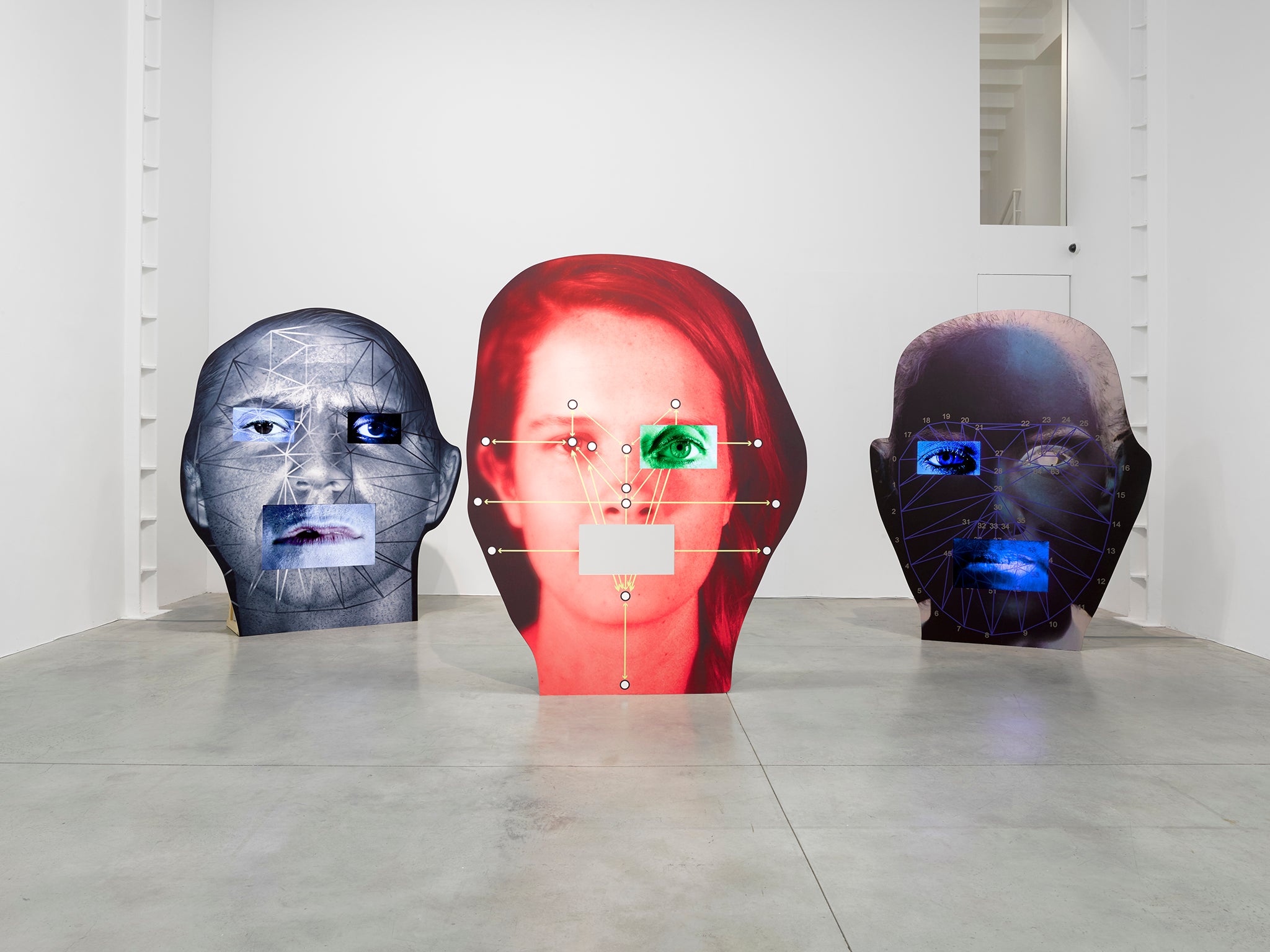Tony Oursler on exploring our uneasy relationship with technology with his new show
His latest work explores the most advanced technology – facial recognition

When artist Tony Oursler’s first used technology back in the late 1970s, he used video tape to make experimental films such as The Weak Bullet, in which two hands painted with eyebrows and lips acted out the characters of a man and a woman. The man died in the end from lead poisoning when a bullet fell in his drink. Forty years later, Oursler’s still at it but the work is significantly more hi-tech. His latest work explores the most advanced technology – facial recognition.
He makes giant faces with video lips and eyes, arranged in a circle around the viewer. They stare blankly ahead; speak slowly and distorted with a low bass sound. One is a bearded black man with a pink painted mouth and X-ray eye, like the iris recognition immigration system used at airports. The way the eye moves evokes emotion. Is it a surprised, sad or angry eye? The latest technologies can translate our micro expressions, the tiny involuntary movements that betray how we truly feel. The faces are dotted with patterns like astronomy constellations, or mathematical grids. These are the areas a machine recognises us from – because certain points on our face never change. There’s a balance between high and lo-fi, futuristic technology lodged within cut out faces, which seem not much more sophisticated than the celebrity party masks people wear.
Oursler’s work evolves alongside new technology, which he explores philosophically: how we interact with it, and what this might mean, does it make us more or less human, might it become the master of us. His sculptures feel sinister, a creepy atmosphere of surveillance surrounds them.
Artists engage with technology in ways as diverse as the technology itself. Belgian artist Cécile B Evans created a digital character for us to interact with online. Her commission for the Serpentine Gallery is titled Agnes and she has a soothing female voice that asks how you’re feeling today, and leads you on a personalised tour through the gallery website, according to your mood. She tells you stories, about the gallery’s director, or a particular artist, and she draws you in. Agnes begins to feel real. It’s like Spike Jonze’s film Her in which a writer falls in love with the operating system in his computer. It’s an emotional engagement, and creates an odd sensation because something fake feels so meaningful to us. Agnes sends gifts to users who put their address in, and she questions her own existence, might she disappear into a universe of data and be lost for ever.
American artist Jordan Wolfson incorporated the most advanced animatronic technology from the LA film industry to make a robot called Female Figure. She wears a transparent mini-skirt, skimpy knickers and white thigh boots, dances like a stripper, and has half a monster’s face. She moves in front of a mirror, looks at herself, and the viewer. She appears so hyperreal that instinctively we respond to her as though our brain can’t help it. You know she’s a machine but it doesn’t matter because she feels like the real thing.
Cory Arcangel began his career with an artwork titled Clouds, based on the Super Mario video game. He erased everything but the background clouds from the game, which were then projected on the wall where they floated like futuristic embodiments of landscape painting. He made a YouTube video in which cats played out the music to Arnold Schoenberg’s Op 11. He did this by finding online videos of cats stepping on certain piano keys, and constructed a digital collage in which they played out the exact notes for Schoenberg’s score. It was also a play on the cute images that go viral on the internet. By using cats, people listened to Schoenberg.
In other work, Arcangel uses low-fi and obsolete technology, stuff that no one wants anymore. Drawings made using old printers, surfwear (comfortable clothes to surf the internet in) for which he used Photoshop’s gradient tool – each colour seamlessly melts into the next. It’s not technology as sinister or godlike, there are no dark forces at work. Arcangel has a comfortable, playful relationship with technology, and for him the internet serves as a muse.
Technology has the ability to create entire worlds, manipulate our emotions, makes us feel. Like Oursler, Japanese artist Tatsuo Miyajima, is from the early generation of artists who use technology. In Life Palace (Tea Room) he made a chamber from red leather filled with hypnotic and flickering digital numbers and blue lights. The colour red, the continuous movement of light seems at odds with Zen-like calm. As though it’s meditation for the attention-deficit disorder of the digital generation. But it is meant to encourage contemplation, for eternal ideas to exist within the most recent. That even within such hi-tech realms, people remain as complex and illogical as ever – and everyone still struggles to concentrate.
Tony Oursler – template/variant/strange/friend is at Lisson Gallery, London NW1 (0207 724 2739) to 7 March
Join our commenting forum
Join thought-provoking conversations, follow other Independent readers and see their replies
Comments